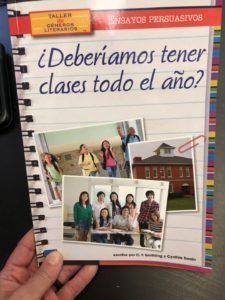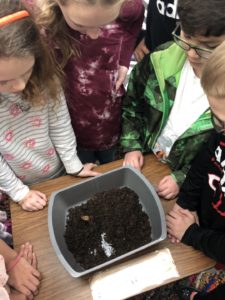History & Geography
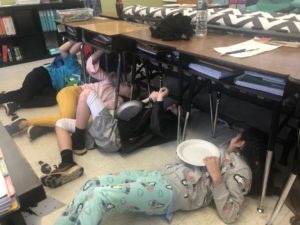 This week we finished out unit on the Renaissance and began our new unit The Reformation. Our objectives were:
This week we finished out unit on the Renaissance and began our new unit The Reformation. Our objectives were:
- find out what it might have felt like for Michelangelo to paint the Sistine Chapel by painting on our backs!
- complete the unit test as a class discussing each question to refresh our memories
- understand how the invention of the printing press affected Europe during the Renaissance and even changed our lives today
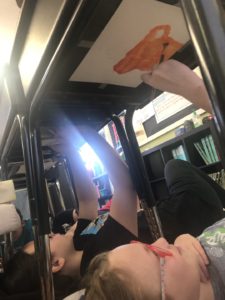 compare inventions from today (like the internet, telephones, and TV) to the printing press
compare inventions from today (like the internet, telephones, and TV) to the printing press
Mathematics
This week we continued working with Ratios. Our objectives were:
- use CUBES (circle, underline, box, evaluate and eliminate, solve and check) to complete word problems about ratios
- change ratios into fractions and fractions into ratios
Lectura
This week we started a new writing assignment: Ensayos persuasivos. To get familiar with the main objectives of this project, we have been conducting weekly class debates. Students have been learning about identifying the purpose and the audience for this project. This week we also talked about the elements and organization of a persuasive argument and the persuasive techniques such as word choice, repetition, emotional appeal, etc. Please take the time to talk to your child about this interesting piece, Deberíamos tener clases todo el ano?, and possibly have a family conversation around this topic! The objectives this week included:
- State a viewpoint and support it with facts, examples, explanations, and expert opinions.
- Establish purposes, audiences and the need for different genres.
- Accurately and meaningfully, identify and explain cause and effect situations that are directly connected to our argumentative writing studies.
- Understand the spelling patterns and semantics of homophones with c. Use these words in different contexts.
- Apply knowledge of the use of capitalization and proper punctuation.
- Understand the use of pronouns in context (demonstrative pronouns and possessive pronouns in particular)
- Learn how to paraphrase text.
- Using the information gathered, accurately organize it into categories.
- Cross-check different sources of information.
Ciencias
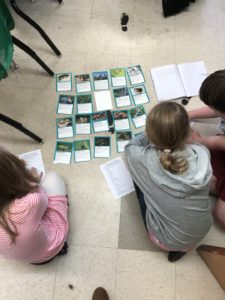 Students explored Earth as a system. Through video, we learned about four subsystems of planet Earth—the geosphere, atmosphere, hydrosphere, and biosphere. After watching the video, students answered questions and summarized the main concepts presented. We focused particularly on the biosphere and described ecosystems by looking at feeding relationships and energy transfers, described as food webs.
Students explored Earth as a system. Through video, we learned about four subsystems of planet Earth—the geosphere, atmosphere, hydrosphere, and biosphere. After watching the video, students answered questions and summarized the main concepts presented. We focused particularly on the biosphere and described ecosystems by looking at feeding relationships and energy transfers, described as food webs.
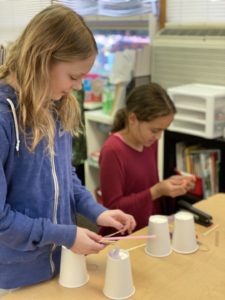 Character Education
Character Education
To continue our Perseverance theme, students were given a supply of materials and asked to invent a device that launched a pom pom into the air. There further it traveled the better! The idea was for them to make several attempts, to persevere through failed attempts and to continue to tweak their device to make it better.
Art with Ms. Kelly
Portraits
Every year I like to have the students work on a portrait project. The goals are:
- Observe shapes of faces
- Observe placement of eyes, nose, mouth
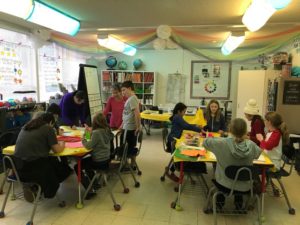
- Observe hair color and texture, and width of shoulders
- Look at reproductions of famous portraits such as Leonardo’s “Mona Lisa”, Paul Klee’s “Senecio,” and Picasso’s self portraits
- Draw a self-portrait
The 4th and 5th Grade class worked on both a realistic portrait and also created a variety of abstract portraits using different materials including pipe cleaners and wire. Their wonderful realistic portraits are on the bulletin board at school, and we have several of their fun abstract portraits in their portfolios at school. Great job everyone!
In February we’re going to start a basket weaving project!
Music with Ms. Nadia
This month we experienced Modest Mussorgsky’s Pictures at an Exhibition. Originally a piano suite, this tribute to Viktor Hartmann’s collection of paintings was later turned into an orchestral symphony by Maurice Ravel. In other words, someone’s life inspired paintings, which inspired a piano suite, which inspired a symphony—which inspired us to create more art! We sketched our impressions of Gnomus, stretched to The Old Castle, walked around to the various Promenades, played Two Truths and a Lie to The Tuileries Gardens and Bydlo, drew portraits of Samuel Goldenberg and Schmulye (and compared our drawings to the real ones!), and both drew renderings of and danced an interpretive dance to Ballet of the Chickens in their Shells. In listening to both piano and orchestral versions, we determined that there are some songs we like better on piano and vis versa. Because he considered himself to be a realist, Mussorgsky’s music focused on how he perceived the world. This emotion translates different when played by multiple instruments vs a soloist. We learned about contrasts while comparing his busy and bustling movement Marketplace to his slow and sad Catacombs. Further contrasts can be heard when comparing the two different versions—the energetic keys to the shrill flutes and the slow dirge of the piano to the ominous horns. These contrasts can be seen in our everyday life, too! Life is fast and slow, happy and sad, light and dark—not just one thing all the time. And thus, life which inspired art which inspired art which inspired art inspires us to make art and look at life a little differently.
We have also been honing our recorder skills through sight-reading. As a class, we know notes B A G E D (or bagel with a “d” instead of an “l”), and have learned songs such as Hot Cross Buns, Snow is Falling, and Why Does Boo Scare You? Students also learned the difference between staccato and legato, and can play quarter notes, eighth notes, half notes, and whole notes. Look at them go!

